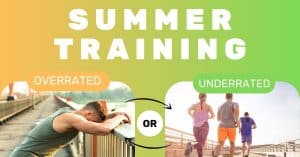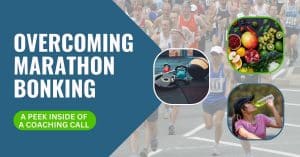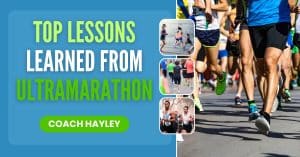The half marathon is one of the most underrated distances you can train for and race.
Not only is it a good stepping stone in volume for newer runners, but it’s a great way to mix up training for more advanced runners.
In today’s episode, Coach Ruiari and Coach Dylan are going to talk about…
- Why moving up or down to the half marathon distance can help you combine speed and strength training.
- Why training for several months consistently is necessary for success in longer races.
- The importance of building your lactate threshold during training, especially for a half marathon
- And specific workouts you can use to crush your next Half Marathon
If you’ve got an upcoming Half Marathon or are thinking about what to do for your next race, this is a great listen.
Here are some of the sample workouts discussed…
Fartlek (short variation):
Option 1: 15 x 1’ at LT, 1’ min at MP + 20-40s
Option 2: 2 x 10 x 1’ at LT, 1’ min at MP + 20-40s ( 4 min between sets)
Option 3: 15 x 1’ at LT, 1’ min at MP + 20-40s, 4 min rest, 10 x 1’ at T, 1’ min at MP + 20-40s, 4 min rest, 5 x 1’ at LT, 1’ min at MP + 20-40
Fartlek (long variation):
Option 1: After a warmup do, 6 miles of 400m at 10k pace, 1200m at MP
Option 2: After a warmup do, 6 – 7 miles of 800m at T to HM pace, 800m at MP
Option 3: After a warmup do, 6 – 8 Miles of 1 mile at T to HM pace, 1 mile at MP
Threshold Intervals:
Option 1: After a warmup, 4 x 1 mile at lactate threshold pace with 60 second continuous jog recoveries
Option 2: After a warmup, 10 x 800 meters at lactate threshold pace with 60 seconds continuous jog recoveries
Option 3: After a warmup, 3 x 2 miles at lactate threshold pace with 2-3 minute continuous jog recoveries
Cutdown Session:
8 miles at Marathon Pace plus 40 – 50s, cutting down 10 seconds per mile
Example: 2 mile warmup, Miles 2-10 (8:00, 7:50, 7:40, 7:30, 7:20, 7:10, 7:00, 6:50, 6:40, 6:30), 2 mile cool down
HM Pace Specific Sessions:
6 x 1 mile at goal HM pace (60s jog recoveries)
4 x 2 Miles at goal HM pace (3 min jog recoveries)
6-8 miles at goal HM pace (continuous after warmup miles)
Finn Melanson [00:00:10]: Hello, fellow runners. I'm your host, Finn Milanson, and this is the Run to the Top podcast, the podcast dedicated to making you a better runner. With each and every episode, we are created and produced by the expert team of coaches. Here@runnersconnect.net where you can find the best running information on the internet, as well as training plans to fit every runner in every budget. The half marathon is one of the most underrated distances you can train for in race. Not only is it a good stepping stone in volume for newer runners, but it's a great way to mix up training for more advanced runners as well. In today's episode, Coach Rory and Coach Dylan are going to talk about why moving up or down to the half marathon distance can help you combine speed and strength training. Why training for several months consistently is necessary for success in longer races, the importance of building your lactate threshold during training, especially for half marathon, and specific workouts you can use to crush your next half marathon. Enjoy, and leave us a comment if you have any questions about the half marathon distance or how to approach your training. If you're looking for the best way to get motivated, improve performance and recovery, and increase focus for your upcoming races, you'll love the new perform from the Amino Company. I'll tell you more about them later in this episode. Or you can check out the research@aminoco.com. RTT. Lagoon specializes in making pillows designed specifically for runners and athletes to help you optimize your sleep and recovery. Learn more@lagoonsleep.com top and get a 15% discount.
Dylan Belles [00:02:00]: Hello everyone, and welcome back to another episode of Uptimpo Talks. I'm Coach Dylan Bellis.
Coach Ruiari [00:02:05]: I'm Coach Rory Moynihan.
Dylan Belles [00:02:06]: Today we're going to talk about the half marathon.
Coach Ruiari [00:02:08]: Indeed, we're going to talk a little bit about racing training for this distance and how it differs from other distances, primarily the marathon, because if you're familiar with the runners connect, I'd say for the most part we accommodate training plans for the marathon because a lot of people that seems to be their primary goal.
Dylan Belles [00:02:26]: This is actually really interesting, mainly because it allows you to still get in another good solid block of marathon training while being able to do a race that is doable agreed.
Coach Ruiari [00:02:38]: And before we get started, I got to say, just from starting off with training for shorter distances in college and then becoming a marathon runner, and then even looking at some ultra distances in the coming year, I have to say, I really strongly believe that training for the marathon puts you in the best position for almost any race distance. I even did a five k time trial just like a month ago, and for the most part, I was still training with the marathon in mind. And yeah, I think it just gives you such a good base. You can always add speed and specialize to go down, and then of course, it's going to help you for the longer distances.
Dylan Belles [00:03:16]: Yeah, absolutely.
Coach Ruiari [00:03:17]: That statement.
Dylan Belles [00:03:18]: I do. Especially if you are not highly specialized. If you're not an elite runner, which most of us are not, you are able to get in a lot of really great volume during the marathon block, but not so extreme to where you're looking at energy systems completely switching to I can only run marathon I can only run marathon distance. That aerobic background foundation will often for people who don't run a lot of mileage but do during the marathon stages will help them for five k, ten k, half marathon. Because even though those races are drastically different from the marathon, they're still primarily aerobic.
Coach Ruiari [00:03:52]: And again, we promote it here. Those slow, easy miles just really ultimately make you more efficient and faster.
Dylan Belles [00:03:58]: Yeah. So this refers back to the 80 20 principle, meaning that 20% of the work gives us 80% of the benefit. So being able to do our easy volume kind of makes up that 80% of our fitness. And so now we only have 20% left to kind of give, which would be our workouts quality sessions, extremities of the long run. But it's interesting because for most of us runners, that is the foundation and that is what helps us most, is easy volume progressed over time.
Coach Ruiari [00:04:31]: True. Well, as promised, let's get back to the half marathon. So I think a good place to start off would just be talking about how this distance differs from the marathon in other races. Let's maybe zero in on racing to start with.
Dylan Belles [00:04:46]: Sure. So with the half marathon, you're not going to have the same energy demands as you would with the marathon. Of course. Now, that doesn't mean that fueling and making sure that you're taking proper hydration is not going to help you. It just means that it becomes less of a pressing issue. And the marathon, we're going through this highly focused prioritized routine. If I take my gels here, I take my water there, and if you mess that up, game over. Half marathons doesn't always happen that way. So first off, the half marathon does not require the same energy needs as the full marathon just because it's less time on foot.
Coach Ruiari [00:05:22]: Yeah. For me, I guess just from a personal standpoint, I think it's really the sweet spot. It's such a fun distance to race because it doesn't really beat you up as much. You can still, of course feel that grind in the last few miles, but yeah, you can bounce back and have other races on the schedule. Still feels like you're running fast. And yeah, the training, even though I said I really like the marathon training, if you are focusing on the half distance, it doesn't really take up your time to the same extent.
Dylan Belles [00:05:50]: Right.
Coach Ruiari [00:05:51]: I think it's perfect distance.
Dylan Belles [00:05:53]: Sure. Yeah. There's a couple of ends of the ways you can come at it as well. You see a lot of runners being very successful when they come from a ten k block and transition into a half marathon. And then you also see it the other way around. You see the guys and girls who have been trained for a marathon and able to come down. So it's a really interesting blend of almost ten K training with marathon training, these two supportive sides of speed and strength that help provide for a fast half marathon. One last thing on racing, at least on my end, is that sometimes you see people who are training for the marathon, they won't race as well for the half. And that mainly because you're not getting that same type of work that you would be doing if you're coming up from ten k. But with the marathon, obviously you're running on much more tired legs, accumulated fatigue, and so sometimes a half marathon just doesn't pan out.
Coach Ruiari [00:06:44]: Yeah, agreed. I think ten k training really does benefit you a lot for the half, just because of the speed sessions you're getting in, which would be a good transition to maybe the type of training you want to do for the half marathon. So if you have a marathon coming up at the end of this year, maybe early 2021, I think we should kind of discuss for the most part what a typical week will look like.
Dylan Belles [00:07:10]: Sure. Now, everybody's going to be coming from different places and training, of course, but I think one of the biggest staples of the half marathon minus the stage, that foundational phase where you're building up mileage, you're building up your long run so that you're able to it's really important for us to focus on the things like, again, that 80 20 principle. Get into the volume. Focus on the volume before you graduate to adding the quality in. So you need to be getting months of that under your belt if you're coming from scratch or even if you're coming from a long layover to really be successful four, five, six months down the road. But once we reach that point in training, I think it's really important that we start to build on our lactate threshold.
Coach Ruiari [00:07:50]: Yeah, this is going to be key.
Dylan Belles [00:07:52]: Right? So lactate threshold, it typically is between anywhere from like a 1 hour race pace to some people even have it up to the half marathon. And so it's a pretty quick pace. It's really nice and supportive and it's going to help you clear out lactate so that you can improve your endurance and be able to get rid of those waste products and again, helps you aerobically, be stronger, more efficient, more economical as the race goes on.
Coach Ruiari [00:08:19]: I think it might even be helpful to just paint a picture with some workouts. So one thing that comes to mind with clearing lactate, a good one, would be the alternating tempo.
Dylan Belles [00:08:28]: Absolutely.
Coach Ruiari [00:08:29]: So fluctuating between around that half marathon pace and actually dropping back to marathon pace for a mile or a k and then going back, just going back and forth.
Dylan Belles [00:08:39]: Yeah, there's a lot of ways that we can definitely do that. Yeah, I like that. You can do, like, the 400 meters at roughly lacking threshold, with 1200 meters equaling out to a mile round marathon pace. And slowly, as you progress that, you can go 800. 800. You can go one k. One k. You can even do it the opposite way around where you do a little bit more threshold work and less marathon work. That is definitely more the advanced side of things. I know that you and I, we like to do it with minute based reps so we even break it down even further by doing 15 by 1 minute on 1 minute off progressing that as much as we can even throwing in set breaks so that we can get in more total volume. But it works the same system. And we've talked about this before.
Coach Ruiari [00:09:18]: Yeah. So we could refer you back to our episode on fart leg workouts as those apply to any type of training.
Dylan Belles [00:09:25]: Exactly. And the other way around is just doing classic threshold intervals. So you can start with 800 meters. I like to doing very short rests, usually 45 to 60 seconds and improving that up to mile repeats.
Coach Ruiari [00:09:40]: And often during this rest you're moving.
Dylan Belles [00:09:42]: Oh yeah, correct.
Coach Ruiari [00:09:43]: Like jogging?
Dylan Belles [00:09:43]: Yeah, jog?
Coach Ruiari [00:09:44]: Jog or thinking of like walking hands in there.
Dylan Belles [00:09:47]: You want to keep things moving a little bit. It's all about encouraging your body to flush that out and become stronger and to get better at getting rid of those waste products. And I've seen runners go from four to six by mile with 60 seconds rest and I've seen them go all the way up to ten by mile. Now, these are usually people who are running 450 to five minute pace for those threshold intervals but generally any more than like 60 minutes of total threshold work is going to be your cap. It's a ton of work and as the race progresses on in the half marathon, you might even switch that to getting closer to race pace. So you can do a little bit more of those intervals with that less recovery because it will be slower than lactate threshold.
Coach Ruiari [00:10:32]: Yeah, I mean, there's all kinds of combinations really, you can get to the same endpoint just depending how you craft the intervals and the rest periods.
Finn Melanson [00:10:45]: I know how nerve wracking the weeks before a big race can be. Moreover, we all know how that sluggish feeling as we back off our training can make us feel like we're losing all of our hard earned fitness. And that's why I love perform from the Amino Company. In the weeks and days leading up to my race, perform immediately gives me energy and focus to help reinvigorate those normally sluggish pre race runs even better. Perform helps reduce fatigue and increases muscle protein synthesis so you can recover faster from both the run and your strength training. I feel great when taking perform, but I appreciate even more that it's all backed by actual science. In fact, the research on amino acids and performance enhancements is well documented with hundreds of studies documenting their effectiveness. You can even use perform during your long runs and workouts and, of course, your race to increase focus and performance during the run itself. So if you're interested in giving perform a try, we've got a special offer for you where you can save 30% and get a free gift by using the code RC 30. Just head to aminoco.com RTT that's Aminoco.com RTT and use the code RC 30 at checkout to save 30% and get a free gift. Changing your pillow to something customized to your sleep position firmness and one that you can keep cool can have a dramatic impact on your sleep quality. Here's some real world data using my old pillow. My Apple Watch data showed that I woke up an average of six times each night and spent 2 hours in deep sleep. When I switched to the lagoon pillow, my average number of times awaking dropped to two per night, and my deep sleep increased by 45 minutes. I've noticed a huge difference in how I feel in the morning, often waking up 30 to 45 minutes before my alarm and not feeling tired. And my data is not an outlier. Using her whoop device, US. Olympic Trials marathon qualifier Caitlin Keane saw her deep restorative sleep increase by 52 minutes when she switched to a lagoon pillow. If you want to see the dramatic, effective pillow design just for you can be head to lagoonsleep.com top. Plus, if you use the code top at checkout, you can also save 15% off your purchase. Again, that's lagoonsleep.com top.
Dylan Belles [00:13:13]: So, I mean, let's let's kind of go into your training a little bit, Rory, and talk about how have you felt with lactate threshold runs in your history as a runner? How has this felt for you and kind of give everybody an idea of what these runs typically feel like and how you've been able to grow on those since you began running.
Coach Ruiari [00:13:34]: I think early on in my training, these workouts were a lot harder and more intimidating. I know kind of a classic one that I've done both with you and other coaches would be like four x 2 miles at close to your half marathon pace, sometimes a little bit faster. I do it slower up here at elevation, but anyway, the rest is kind of rolling, continuous, maybe two to three minutes of jogging. And I know just from where I was at, like, around college or in the years after, I just didn't have enough mileage to really handle those as easily. I just did that workout, for instance, I think I did three by 2 miles, and even up here at 7000ft, it felt so much easier because I'm averaging around 80 ish to 90 miles a week currently.
Dylan Belles [00:14:19]: Sure.
Coach Ruiari [00:14:20]: But yeah, that's why I think going back to what you said previously, that foundational phase is so important, you're still going to want to have long runs that are going to help you with these sessions. You might not have to go more than 15 miles for the long run, but also consider adding a second kind of moderate long run just to get you ready for these sessions.
Dylan Belles [00:14:40]: I like that. Yeah.
Coach Ruiari [00:14:41]: I guess to make my long answer shorter, they've gotten easier.
Dylan Belles [00:14:45]: Sure. Yeah. The volume is important. The totality of the volume is important, allows you to do more work at threshold up to half marathon pace. That's kind of what we're looking at. So cool. So let's talk about the other end of the equation. Now, everybody loves the tempo run, and some people get tempo run confused with threshold. They're very drastically different. Thresholds can be around 1 hour race pace, up to half marathon pace, whereas a tempo run is going to be typically around marathon pace, sometimes down to half marathon.
Coach Ruiari [00:15:11]: It can be a little faster, but.
Dylan Belles [00:15:14]: Most of the time when we're looking at marathon pace or we're looking at tempos, we're looking around marathon pace. So this is going to help you with your half marathon and working the mental aspects of being able to sustain a pace for a long time, but also to help the overall aerobic component, the endurance component, that is necessary. But if it comes to weighing out which one matters more, definitely being closer to race specificity during that race specific period is going to weigh out.
Coach Ruiari [00:15:45]: Yeah. So the threshold pace workouts would be more essential. I'd say the tempo might be more beneficial early on in training, like with the foundational phase. Is that where you'd kind of put.
Dylan Belles [00:15:55]: Those yeah, I agree. And I definitely think that it's worthwhile to continue revisiting them, but I don't think that you're going to have a tempo run in that half marathon phase and think to yourself, I'm ready to run a half marathon because of this. I did a ten mile tempo at marathon pace. Yeah, it might be relative to you, but that's not necessarily going to tell you that you're ready to race a half marathon, but still essential part of training nonetheless. Okay, so let's talk about the tempo run. That would be specific for the half marathon.
Coach Ruiari [00:16:30]: Definitely.
Dylan Belles [00:16:30]: And so it's going to be kind of right there in the middle. It will be half marathon pace. And I do think that one thing that would be indicative is hitting a five to six mile tempo at half marathon pace. I really don't think that you need too much more than that because outside of that, that effort is going to be too hard.
Coach Ruiari [00:16:46]: That's tiring. Yeah, that's a long time to be running.
Dylan Belles [00:16:48]: It's going to be too much. And I've heard of people being able to extend these up to 8 miles, sometimes even 10 miles in training, and I just think to myself, well, if that's what you're going to be running in the half marathon, then you're either overdoing it in your training or you're underperforming on race day. So typically, five to 6 miles a half marathon pace should be about the extent of which you should be doing those tempo runs.
Coach Ruiari [00:17:08]: Yeah, agreed. Now, that almost sounds like it's approaching a half marathon race effort, and for most of our listeners who are beginning runners or intermediate or just not racing at that very top elite level yeah, five to six, even like, a four mile tempo. I've done a lot of that. Those distances is fine at that pace.
Dylan Belles [00:17:27]: Sure. Awesome. Well, hey, I think we wrapped up the half marathon pretty well today.
Coach Ruiari [00:17:31]: I just wanted to add, of course, you got to make a plug for our coaching services if you really want us to put together a solid training plan for you. You got to sign up with Runners Connect if you're not already part of the community, because we'll give you the most tailored experience to get ready for this distance, because it's one thing to listen and hear what you're supposed to do versus seeing it, like, week by week.
Dylan Belles [00:17:54]: Yeah, I actually love that you brought that up. I've been reading a book on basically the Soviet Union's weight training routine, principles and everything, and they talked about how the programming is the essential piece of the puzzle. So you need to have the programming node, the when and why, but what even outweighs that even more is this the point they call a coach's eye. And basically what that means is that, sure, you can follow a training plan from start to finish, but without the proper guidance from the coaches and having the coach's eye on seeing, hey, this is how I approached it. This is what happened. This is how you felt. This is what you look like, then we often will kind of fail to meet those goals of ours because we don't have the guidance and the outside influence of helping ourselves continue to improve. So just to echo what you were saying, if you guys are looking for a half marathon training plan, coach Rory as well as I are more than happy and are excited to help more people tackle the distance this year or into 2021.
Coach Ruiari [00:18:57]: Yeah, it doesn't matter who you are. I mean, I feel like I have a pretty firm grasp on what my training should be, but I still like to have a coach telling me what to do and giving me feedback. Everyone benefits regardless of your experience level.
Dylan Belles [00:19:09]: Yeah, absolutely. So take advantage of it, go to runnersconnect.net and sign up, and we'll get your schedule started as quickly as possible.
Coach Ruiari [00:19:17]: All righty, thanks for tuning in. I say we close it out here this has been another episode of Uptempo Talks. I'm Coach Roy Moynihan.
Dylan Belles [00:19:24]: And I'm Coach Dylan Bellis.
Coach Ruiari [00:19:26]: Have a great run today.
Finn Melanson [00:19:42]: Thanks for listening to the Run to the Top podcast. I'm your host, Finn Mulanson. As always, our mission here is to help you become a better runner with every episode. Please consider connecting with me on Instagram at Wasatch, Finn and the rest of our team at Runners Connect. Also consider supporting our show for free with a rating on the Spotify and Apple podcast players. Lastly, if you love the show and want bonus content, behind the scenes experiences with our guests, and premier access to contests and giveaways and subscribe to our newsletter by going to RunnersConnect. Net podcast. Until next time, happy trading.
Sign up to receive email updates
Enter your name and email address below and I'll send you periodic updates about the podcast.
Connect, Comment, Community
- Follow RunnersConnect on Instagram
- Join the Elite Treatment where you get first dibs on everything RTTT each month!
- Runners Connect Winner’s Circle Facebook Community
- RunnersConnect Facebook page
- GET EXPERT COACHING AT RUNNERSCONNECT!
This week’s show brought to you by:
Perform from the Amino Company
Perform is an amino acid based formulation that I simply add to my water bottle during my run. It tastes great and is easy on my stomach.
Clinical studies have shown that Perform helps improve endurance, reduce fatigue, and increases muscle protein synthesis so you recover faster after the run. Check out the research here: aminoco.com/rttt
If you’re interested in learning more and giving Perform a try, we’ve got a special offer for you where you can save 30% by using the code RC30. Just head to: aminoco.com/rttt and use the code RC30 at checkout to save 30%
Lagoon
Lagoon specializes in making pillows designed specifically for runners and athletes to help them optimize their sleep and recovery.
Their sleep quiz pairs you with the perfect pillow for you based on sleep position, body size and more.
And the data on sleep improvement isn’t only from research papers. Using her whoop device, US Olympic Trials marathon qualifier Caitlin Keen saw her deep, restorative sleep increase by 52 minutes when she switched to a Lagoon pillow.
If you want to see the dramatic affect a pillow designed just for you can be, head to lagoonsleep.com/top
Then take their awesome 2 minute sleep quiz that matches you with the Lagoon pillow that’s perfect for you. Plus, if you use the code TOP at checkout, you’ll also save 15% off your purchase.









